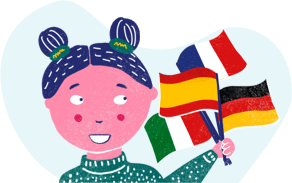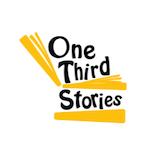The thing is, most of these resources tend to focus on improving reading, listening and writing skills – what about ways to help kids practise speaking? Never fear! In this article, we’ll talk you through five fabulous speaking activities to try with your child, whether they’re learning French, Spanish, German or Italian. And if you want a free, digital sample of the kinds of activities kids receive each month as part of a full subscription to One Third Stories, sign up for a free ebook, audiobook and activity ideas.
#1 What’s the question?
This is a great, zero-prep activity that’s a surefire way to get kids practising asking questions and speaking about themselves in their new language. It’s perfect to do one-to-one with your child, but works well with multiple participants too!
Start by giving each participant (including yourself!) a piece of paper. Everyone starts by writing their name in the middle of the page. This would be the answer to the question “What’s your name?”.
Then, dotted around the page, each participant then writes 5-10 words or phrases that are answers to potential questions about themselves – for instance, you could write the name of your best friend, your favourite film, your age, your dream holiday destination – anything!
Everyone then shows the group their page, before taking turns to ask the correct questions that elicit each answer. The activity ends when every question has been asked!
#2 Mute the video!
This is a fun, multimedia activity that really fires kids’ imaginations! On YouTube, find a clip from a video, film or TV show. Try to choose a clip in which lots of things happen, or one in which it isn’t obvious what’s happening or what is being talked about.
Mute the video, and watch the clip together all the way until the end. When it’s finished, ask your child to explain (in their new language, of course!) what they think was happening, and what they think will happen next.
After you’ve finished discussing your predictions, watch the video with the sound on. How accurate were everyone’s predictions?
#3 Role play
Role playing is a wonderful way to show your child some of the contexts where their new language might come in useful.
Together, make a list of some scenarios – these could be as general as “travelling abroad” or as specific as “inviting some other kids to come and play football”! Once you have a good list, write them down on little pieces of paper, then pick one at random and act them out!
When you’ve finished each one, note down any vocabulary that it would have been useful to know – you can look these up and learn them later.
#4 The elevator pitch
This is a fabulous, creative activity that encourages kids to speak in their new language for extended periods, as well as practising giving presentations and using persuasive language.
Start by challenging your child to think of a business, product or idea that they believe has the potential to be very successful in future. Discuss the details of their idea, noting down its key features and any important vocabulary associated with it.
Then, it’s time to role play! You take the role of a wealthy investor, while your child is a plucky entrepreneur. You find yourselves together in an elevator – now is their chance! Your child has 60 second to convince you why their idea is the next big thing, and why you’d be crazy not to invest.
#5 Two truths and a lie
This activity never fails to get kids talking and, excitingly, lying in their new language! It’s also a great way to practise question formation.
The rules are simple: both you and your child (or children – this works well with groups of any size) write down three sentences about yourselves. Two must be true, while the other is a big, fat fib! Be creative, and make sure that none of the sentences is anything you and your child already know about each other.
Then, read each other your three sentences and ask questions – the objective is to convince each other that all three sentences are true, and to identify one another’s lies! But be careful, as you only have one opportunity to guess. Better keep those faces straight!



Choose a language
One Third Stories courses are available in French, Spanish, Italian and German.
Select a subscription
Choose between monthly or annual payment options.
Start learning
Receive your first audiobook and Story Box, and let the learning begin!.

Choose a language
Our courses are available in French, Spanish, Italian and German.

Select a subscription
Choose between monthly or annual payment options.

Start learning
Receive your first audiobook and Story Box, and let the learning begin!.
